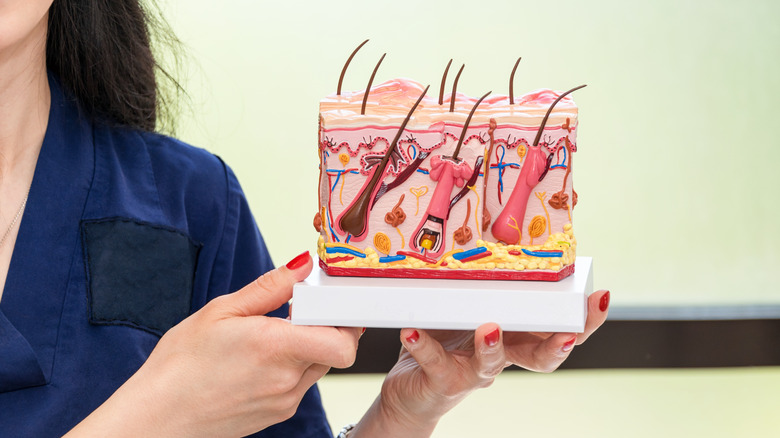How Long Does It Take For Skin To Renew Itself?
Our skin undergoes its own unique life cycle. This small but mighty organ may only be a few millimeters thick, but it is so expansive that, on average, it weighs between 7.5 pounds and 22 pounds, relative to height and weight (via InformedHealth.org).
Skin serves the body in a number of ways. Not only does it act as a protective barrier from the outside elements, but it also regulates body temperature, stores fat and water, releases hormones, and enables our sense of touch. Our skin is made up of multiple layers, each one progressively deeper than the prior: the epidermis, or surface layer that's visible to the eye, the dermis, otherwise known as the middle layer, and the subcutis as the deepest layer.
Skin will regenerate itself for different reasons. For example, new skin will be produced in response to a cut or wound, but skin also undergoes a routine shedding cycle. How long does it take for new skin to form? It depends on the situation.
Skin renews itself faster in response to injury
As part of the epidermis' natural life cycle, new skin cells are formed, which make their way to the skin's surface every four weeks to take the place of old cells that have died and flaked off (via InformedHealth.org).
However, skin renewal is accelerated in response to injury. According to the University of Michigan Health, scrapes have a healing time of roughly three to seven days, while deeper cuts may take up to two weeks or more to fully heal. Scrapes on the surface level of the skin will form new skin cells from the base of the wound and move upwards. For cuts that penetrate the deepest layers of the skin, new cells will form around the edges of the injury and work their way inward.
The Dermatology Associates of Atlanta explains via Scientific American that, when it comes to permanent markings like tattoos, "The cells in the superficial or upper layers of skin, known as the epidermis, are constantly replacing themselves. This process of renewal is basically exfoliation (shedding) of the epidermis. But the deeper layers of skin, called the dermis, do not go through this cellular turnover and so do not replace themselves. Thus, foreign bodies, such as tattoo dyes, implanted in the dermis will remain."


